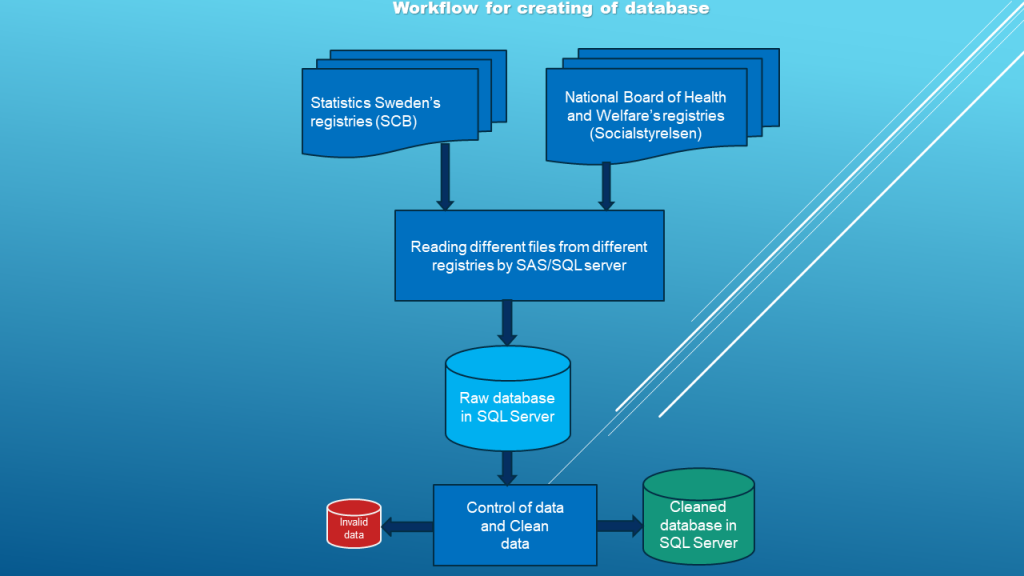Deprescribing in older adults register data
This is an update of a register extraction previously located at KI-NVS. The new extraction will completely replace the old extraction. We have stored the new data base at local servers at the Department of Medical Epidemiology and Biostatistics, Karolinska Institutet. Moreover, we have created a more transparent and structured workflow to allow faster and more stringent dataset creation, cleaning and mapping. The data is delivered during fall (September) 2021, we have updated database with data from SCB and National Board of Health and Welfare until 2020.
Population:
Includes all persons 65 years and older in Sweden, from 2004-2020 (cumulative number of individuals about 3,493,683 persons). The population is constructed by Statistics Sweden using the Register of the Total Population (RTB registry).
Record linkage:

The database is record-linkage individually using Swedish Personal Identification Numbers (PIN). The linkage is performed by register-holding authorities. The PINs are pseudonymized at data delivery.
Included registers:
1- Registries from Statistic Sweden (SCB): We have access to a variety of sociodemographic- economic data from Statistics Sweden, including education, occupation, income, cohabitation, neighbourhood characteristics etc. Period: 2004-2020. We have linkages to different registries from SCB as following:
• Register of total population (RTB); Available variables include sex, date of birth, country of birth, municipality of residence, living arrangement, civil status, year of immigration and emigration.
• Incomes and Taxation Register (IoT)
• Longitudinal integration database for health insurance and
labour market studies (LISA).
• Longitudinal database for integration studies (STATIV).
• Population and housing censuses (FoB).
• Education Register (UREG).
• Geography Database (GDB).
2- Registries from The National Board of Health and Welfare:
- The Swedish Prescribed Drug Register: includes all filled prescriptions outside of hospital wards. Available variables include date of prescription, date of dispensing, type of dispensing, total dose, prescribed daily dose (free text), number of DDDs dispensed, ATC code, costs. Period: 2006-2020. Note: We have created a unique routine to calculate end-date of medication use based on free-text information about dosage.
- The National Patient Register: includes inpatient care and specialised outpatient care. It contains 99% of all somatic and psychiatric hospital discharges. Available variables include date of admission/discharge, planned/unplanned admission, main diagnosis, secondary diagnoses, injuries, medical or surgical procedures, department of admission. Period: 2004-2020
- The National Cause of Death Register: contains 99% of all deaths that are documented with an underlying cause of death. Available variables include underlying and contributing causes of death, place of death. Period: 2004-2020
- The Swedish Register of Social Services: is a routinely collected administrative register that includes monthly information on publicly founded long term care (for example nursing home and home help services). 2013-2020
Research topics
We have a broad ethical approval to study overall health and health/elder care use in older adults in Sweden.
However, some main foci of the research group is:
- Pharmacoepidemiological and drug use research
This area spans everything from detailed analyses of safety and effectiveness of specific drug treatments to broad descriptions of overall drug utilization.
- Use of eldercare and health care
Investigating sociodemographic differences in use of eldercare and health care
- Covid-19
We have received a number of grants to study Covid-19 using Swedish register data. This will be made possible with the new register extraction.
Identified need of database manager/administer
We have previously done all database management within the research group. We have identified a number of shortcomings with this approach (e.g. lack of documentation, inconsistent coding practices etc.). Therefore, we have a database manager with expertise to conduct/provide support regarding data cleaning, database management, dataset creation, data documentation.
2. Mapping of database to Common Data Model
We have received a pre-agreement to map our Swedish register data to a Common Data Model. The financer is EDHEN (The European Health Data & Evidence Network), see more information on the organization (https://www.ehden.eu/) and the specific grant (https://www.ehden.eu/open-calls/04-2021-4th-data-partner-call/).
More information regarding the Common Data Model
Our register will be mapped to the OMOP Common Data Model. The OMOP Common Data Model has also been adopted by the OHDSI community (open-science network for federated analysis). More information about the Common Data Model, OMOP and OHDSI is available in Book of OHDSI (https://ohdsi.github.io/TheBookOfOhdsi/OhdsiCommunity.html).
The tasks required for data mapping (for information see more in Book of OHDSI, chapter 6 and 8)
- Dataset profiling and documentation
- Generation of the ETL Design
- Mapping of source vocabularies
- Technical architecture design
- Technical ETL Development
- Setting up of Infrastructure
- Installation of the OHDSI / EHDEN tools
- (Technical) testing of the ETL
- Data Quality Assessment
- Completion of the data catalogue
- Inspection Report
Finance and miscellaneous
We have been granted 100,000 Euro to conduct the mapping. It is also required to sub-contract a SME (external enterprise), both to support the mapping but also to conduct the final Inspection Report. A list of the certified SMEs is available (), we have not yet entered negotiations with any SME.
Currently, KI Avtal is inspecting the agreement. We hope to start the mapping project in before the end of 2021. We have recruited one postdoc with a background in biostatistics who will be central in the project.
Identified need of collaboration with IT
We believe that the expertise of the IT department would be extremely useful for the project. We also hope that the mapping and associated work would be of a more general interest both for IT and other groups at MEB.